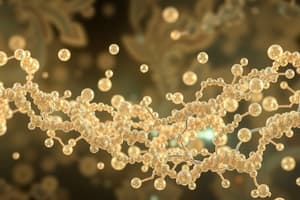Podcast
Questions and Answers
Why is alkaline phosphatase (ALP) referred to as a hydrolase enzyme?
Why is alkaline phosphatase (ALP) referred to as a hydrolase enzyme?
Because it uses water to cleave phosphate groups from molecules.
Besides liver and bone issues, what other conditions might an ALP test help diagnose?
Besides liver and bone issues, what other conditions might an ALP test help diagnose?
Biliary obstruction or cancer.
How do conditions affecting bone growth influence ALP levels in the blood?
How do conditions affecting bone growth influence ALP levels in the blood?
Conditions affecting bone growth or increased bone cell activity can elevate ALP levels.
Why would a doctor order an ALP test as part of a liver function test?
Why would a doctor order an ALP test as part of a liver function test?
How does an ALP test aid in diagnosing biliary obstruction?
How does an ALP test aid in diagnosing biliary obstruction?
How do osteoblasts contribute to the presence of ALP in bone?
How do osteoblasts contribute to the presence of ALP in bone?
How does the ALP level in children and adolescents typically compare to that in adults, and why?
How does the ALP level in children and adolescents typically compare to that in adults, and why?
What role do zinc and magnesium play in ALP levels, and how does this relate to hypothyroidism?
What role do zinc and magnesium play in ALP levels, and how does this relate to hypothyroidism?
Explain how hyperthyroidism can indirectly affect ALP levels and liver function, according to the text.
Explain how hyperthyroidism can indirectly affect ALP levels and liver function, according to the text.
How does ALP relate to vascular calcification in myocardial infarction?
How does ALP relate to vascular calcification in myocardial infarction?
Flashcards
Alkaline Phosphatase (ALP)
Alkaline Phosphatase (ALP)
An enzyme responsible for removing phosphate groups from molecules like nucleotides and proteins.
Dephosphorylation
Dephosphorylation
The process of removing a phosphate group.
ALP Enzyme Location
ALP Enzyme Location
Liver, small intestine, bones, kidney, and placenta.
ALP in the Liver
ALP in the Liver
Signup and view all the flashcards
ALP in the Bone
ALP in the Bone
Signup and view all the flashcards
Symptoms for ALP Order
Symptoms for ALP Order
Signup and view all the flashcards
ALP Levels in Children
ALP Levels in Children
Signup and view all the flashcards
Clinical Significance of ALP
Clinical Significance of ALP
Signup and view all the flashcards
Osteoblastic Bone Tumors
Osteoblastic Bone Tumors
Signup and view all the flashcards
Pregnancy and ALP
Pregnancy and ALP
Signup and view all the flashcards
Study Notes
Alkaline Phosphatase (ALP) Overview
- ALP is a hydrolase enzyme.
- It removes phosphate groups from molecules like nucleotides, proteins, and alkaloids in a process called dephosphorylation.
Location
- ALP exists in several tissues including the liver, small intestine, bones, kidney, and placenta.
- Highest concentrations are in cells of the bone and liver.
ALP in the Liver
- In the liver, ALP can be found on the edges of cells that form bile ducts: small tubes that drain bile to the bowels, aiding in fat digestion.
ALP in Bone
- ALP in bone is produced by osteoblasts, which are special cells involved in bone formation.
When to Order an ALP Test
- An ALP test can be part of routine lab testing, often included in a liver function test.
- It may also be ordered with other tests when someone has liver or bone disorder symptoms.
- Liver disorder symptoms can include weakness, fatigue, loss of appetite, nausea, vomiting, abdominal pain or swelling, jaundice, dark urine, light-colored stool, and itching (pruritus).
Factors Affecting ALP Levels
- Conditions affecting bone growth or increasing bone cell activity can change ALP blood levels.
- Children and adolescents have higher ALP levels than adults due to bone growth.
- ALP is often very high during growth spurts in both boys and girls.
Clinical Significance
- ALP is used to detect liver disease, bone disorders, biliary obstruction, and cancer.
Elevated ALP Enzyme Conditions
- Biliary obstruction (blocked bile duct): ALP is high in the edges of cells that form bile ducts in this case.
- Osteoblastic bone tumors: Detects cancers that have spread to bones.
- Osteomalacia: Bone softening in adults, typically from prolonged vitamin D deficiency.
- Hepatitis: Damaged liver cells release more ALP into the blood.
- Leukemia: Cancer of WBCs, starts in the bone marrow.
- Lymphoma: Cancer that starts in the cells of the lymph system.
- Paget's Disease: Diagnoses Paget's disease, which causes malformed bones.
- Sarcoidosis: Immune system overreaction leads to clusters of inflamed tissue (granulomas) in organs.
- Hyperthyroidism: Too much thyroid hormone (T3 and T4) causes increased ALP, with excess T3 inducing apoptosis of hepatocytes and liver dysfunction.
- Hyperparathyroidism: An excess of parathyroid hormone (PTH) from the parathyroid gland can elevates ALP due to high bone resorption.
- Myocardial infarction: Increased ALP levels are related to promoting vascular calcification in the case of a myocardial infarction, as the ALP enzyme inhibits vascular calcification.
- Pregnancy: Increased ALP from placental release and fetal bone growth.
Lowered ALP Enzyme Conditions
- Low ALP levels may occur after blood transfusions or heart bypass surgery.
- Zinc and magnesium deficiencies, as seen in hypothyroidism, can lower ALP levels.
- Hypophosphatasia is a rare genetic bone metabolism disorder that causes low ALP levels.
- Malnutrition, protein deficiency, and Wilson's disease are possible causes.
- Some drugs, like oral contraceptives, may decrease ALP levels, while anti-epileptics may increase them.
- The normal ALP range for adults is 32-92 IU/L.
Principle of ALP Test
- The colorimetric determination of ALP activity involves a reaction where phenylphosphate converts to phenol and phosphate.
- Free phenol from hydrolysis then reacts to form a red-colored complex, measured at 510 nm, directly proportional to ALP activity.
- Sodium arsenate is also used within this test.
Studying That Suits You
Use AI to generate personalized quizzes and flashcards to suit your learning preferences.




